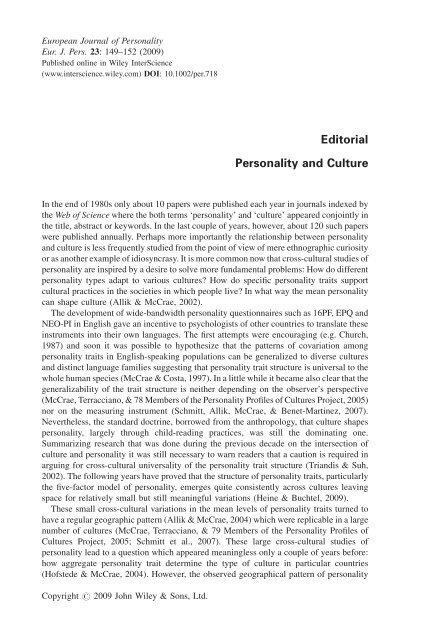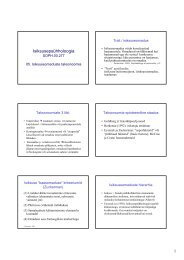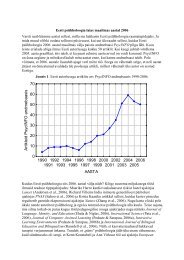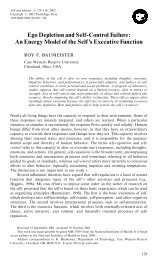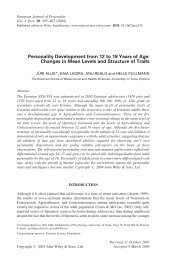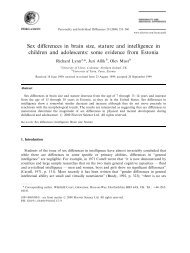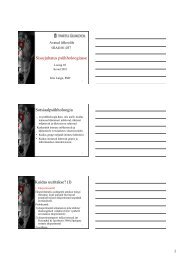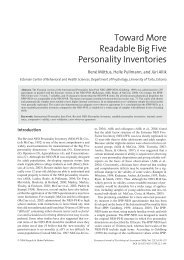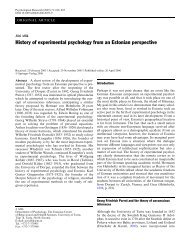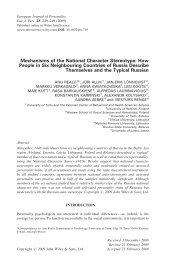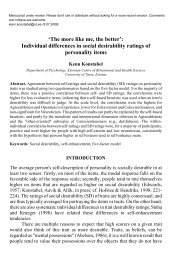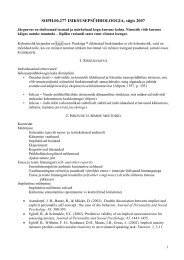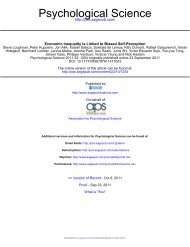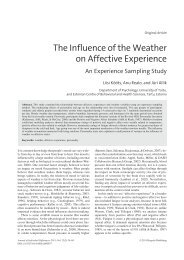Personality and culture - Wiley Online Library
Personality and culture - Wiley Online Library
Personality and culture - Wiley Online Library
You also want an ePaper? Increase the reach of your titles
YUMPU automatically turns print PDFs into web optimized ePapers that Google loves.
European Journal of <strong>Personality</strong><br />
Eur. J. Pers. 23: 149–152 (2009)<br />
Published online in <strong>Wiley</strong> InterScience<br />
(www.interscience.wiley.com) DOI: 10.1002/per.718<br />
Editorial<br />
<strong>Personality</strong> <strong>and</strong> Culture<br />
In the end of 1980s only about 10 papers were published each year in journals indexed by<br />
the Web of Science where the both terms ‘personality’ <strong>and</strong> ‘<strong>culture</strong>’ appeared conjointly in<br />
the title, abstract or keywords. In the last couple of years, however, about 120 such papers<br />
were published annually. Perhaps more importantly the relationship between personality<br />
<strong>and</strong> <strong>culture</strong> is less frequently studied from the point of view of mere ethnographic curiosity<br />
or as another example of idiosyncrasy. It is more common now that cross-cultural studies of<br />
personality are inspired by a desire to solve more fundamental problems: How do different<br />
personality types adapt to various <strong>culture</strong>s? How do specific personality traits support<br />
cultural practices in the societies in which people live? In what way the mean personality<br />
can shape <strong>culture</strong> (Allik & McCrae, 2002).<br />
The development of wide-b<strong>and</strong>width personality questionnaires such as 16PF, EPQ <strong>and</strong><br />
NEO-PI in English gave an incentive to psychologists of other countries to translate these<br />
instruments into their own languages. The first attempts were encouraging (e.g. Church,<br />
1987) <strong>and</strong> soon it was possible to hypothesize that the patterns of covariation among<br />
personality traits in English-speaking populations can be generalized to diverse <strong>culture</strong>s<br />
<strong>and</strong> distinct language families suggesting that personality trait structure is universal to the<br />
whole human species (McCrae & Costa, 1997). In a little while it became also clear that the<br />
generalizability of the trait structure is neither depending on the observer’s perspective<br />
(McCrae, Terracciano, & 78 Members of the <strong>Personality</strong> Profiles of Cultures Project, 2005)<br />
nor on the measuring instrument (Schmitt, Allik, McCrae, & Benet-Martinez, 2007).<br />
Nevertheless, the st<strong>and</strong>ard doctrine, borrowed from the anthropology, that <strong>culture</strong> shapes<br />
personality, largely through child-reading practices, was still the dominating one.<br />
Summarizing research that was done during the previous decade on the intersection of<br />
<strong>culture</strong> <strong>and</strong> personality it was still necessary to warn readers that a caution is required in<br />
arguing for cross-cultural universality of the personality trait structure (Tri<strong>and</strong>is & Suh,<br />
2002). The following years have proved that the structure of personality traits, particularly<br />
the five-factor model of personality, emerges quite consistently across <strong>culture</strong>s leaving<br />
space for relatively small but still meaningful variations (Heine & Buchtel, 2009).<br />
These small cross-cultural variations in the mean levels of personality traits turned to<br />
have a regular geographic pattern (Allik & McCrae, 2004) which were replicable in a large<br />
number of <strong>culture</strong>s (McCrae, Terracciano, & 79 Members of the <strong>Personality</strong> Profiles of<br />
Cultures Project, 2005; Schmitt et al., 2007). These large cross-cultural studies of<br />
personality lead to a question which appeared meaningless only a couple of years before:<br />
how aggregate personality trait determine the type of <strong>culture</strong> in particular countries<br />
(Hofstede & McCrae, 2004). However, the observed geographical pattern of personality<br />
Copyright # 2009 John <strong>Wiley</strong> & Sons, Ltd.
150 Editorial<br />
traits was not always in accordance with the common sense. It is hard to convince both<br />
experts <strong>and</strong> lay persons that Japanese respondents, for example, are low in order,<br />
dutifulness, <strong>and</strong> self-discipline because they regularly score very low on the<br />
conscientiousness scale. Or what sense it does make that in those US states where<br />
people score high on conscientiousness the rate of murder <strong>and</strong> robbery per capita is higher?<br />
(Rentfrow, Gosling, & Potter, 2008). The picture became even more complex when it<br />
turned out that those beliefs people hold about personality characteristics typical of<br />
members of their own <strong>culture</strong>s do not converge with assessed traits (Terracciano et al.,<br />
2005). These discrepancies pose some methodological challenges for comparison of<br />
personality traits across <strong>culture</strong>s (Ashton, 2007; Heine, Buchtel, & Norenzayan, 2008;<br />
Perugini & Richetin, 2007).<br />
Although tendencies to experience either positive or negative emotions are one of the<br />
most reliable indicators of personality dispositions (Watson, 2000), personality psychology<br />
<strong>and</strong> psychology of emotions have developed according to their own separate paths. While<br />
early personality psychologists were primarily inspired by Margaret Mead, researchers of<br />
human emotions were simply unable to escape from the powerful ideas of Charles Darwin.<br />
This is one of the reasons why the big six basic emotions (Ekman, Sorenson, & Friesen,<br />
1969) were accepted earlier than the idea of the big five personality traits. Further research<br />
has convincingly demonstrated that universality emotions spreads also to antecedents of<br />
emotions (Scherer, 1997) <strong>and</strong> their display rules (Matsumoto, 1990). While links between<br />
studies of emotion <strong>and</strong> personality are growing stronger, Matsumoto proposed that many<br />
cross-cultural differences in the perception, expression <strong>and</strong> interpretation of emotions can<br />
be explained by personality traits (Matsumoto, 2006). A parallel development in these two<br />
areas, personality <strong>and</strong> emotion research, is by itself a strong argument that they could<br />
benefit from emerging integration between these areas.<br />
This special issue contains six papers from the leading research groups which have been<br />
instrumental in the shaping of the personality-<strong>culture</strong> <strong>and</strong> personality-emotions research<br />
areas during the last two decades. As the editors of the special issue we are hoping that<br />
these six papers contain several new ideas <strong>and</strong> findings that could stimulate progress in<br />
these two areas.<br />
Timothy Church (2009) discusses a possible integration of trait <strong>and</strong> cultural psychology<br />
perspectives, two dominant theoretical approaches in the study of <strong>culture</strong> <strong>and</strong> personality.<br />
This paper summarize the results of cross-cultural studies Church <strong>and</strong> his colleagues have<br />
conducted to test elements of this integrated perspective <strong>and</strong> draw a roadmap in which<br />
direction future studies could be planned.<br />
Steven Heine (Falk, Heine, Yuki, & Takemura, 2009) <strong>and</strong> his colleagues return to the<br />
problem why Westerners self-enhance more than East Asians, at least when it concerns<br />
traditional self-report questionnaires. One way to answer this question is to use some<br />
alternative assessment techniques, particularly the implicit association tests. Their study<br />
provides an answer to the question how much the implicit association test are suited for the<br />
study of cultural differences <strong>and</strong> which method gives the best approximation to ‘true’ selffeelings.<br />
Robert McCrae (2009) are introducing a new concept—ethos—in addition to more<br />
studied assessed personality traits <strong>and</strong> national character stereotypes. Ethos is social<br />
institutions that reflect the operation of personality traits. Although experts can reliably<br />
estimate ethos in Japan <strong>and</strong> US these measures of ethos are not reducible to aggregate<br />
personality traits or national character stereotypes suggesting that these three layers related<br />
to personality are operating relatively independently in the society.<br />
Copyright # 2009 John <strong>Wiley</strong> & Sons, Ltd. Eur. J. Pers. 23: 149–152 (2009)<br />
DOI: 10.1002/per
Editorial 151<br />
Realo et al. (2009) try to solve a puzzle why national character stereotypes do not agree<br />
with assessed personality traits. One possible answer is that national character stereotypes<br />
are not describing personality stereotypes of one’s own nation but they are formed in<br />
contrast to the perception of a dominant neighbouring nation or to people’s self-rated<br />
personality traits: the typical in-group or out-group member is portrayed in less socially<br />
desirable terms than people’s ratings of their own personality.<br />
Matsumoto, Hee Yoo <strong>and</strong> Fontaine, 2009 <strong>and</strong> his colleagues introduce a concept called<br />
context differentiation (CD) demonstrating how cultural display rules for emotional<br />
expressions are associated with context. Findings indicate that <strong>culture</strong>s were reliably<br />
associated with measures of CD. The framework <strong>and</strong> findings provide a platform for future<br />
research examining how individuals differentiate their behaviours across contexts, <strong>and</strong> how<br />
<strong>culture</strong>s facilitate that differentiation.<br />
Klaus Scherer <strong>and</strong> his team (Scherer & Brosch, 2009) try to elucidate how cultural<br />
factors may encourage the development of affective personality traits or emotional<br />
dispositions by producing or rewarding specific appraisal biases. They propose that cultural<br />
beliefs, values or practices may encourage certain types of appraisal bias <strong>and</strong> may thus<br />
provide an explanation for widely held stereotypes about cultural affect patterns.<br />
We believe that all these six studies exploring the relationship between personality <strong>and</strong><br />
<strong>culture</strong> in their own way advance our current knowledge in the result of which we will be<br />
more prepared to underst<strong>and</strong> both human personality <strong>and</strong> human <strong>culture</strong>.<br />
JÜRI ALLIK <strong>and</strong> ANU REALO<br />
Department of Psychology, University of Tartu, Estonia<br />
REFERENCES<br />
Allik, J., & McCrae, R. R. (2002). A five-factor theory perspective. In McCrae, R. R., & Allik J.<br />
(Eds.), The five factor model of personality across <strong>culture</strong>s (pp. 303–322). New York: Kluwer<br />
Academic/Plenum Publishers.<br />
Allik, J., & McCrae, R. R. (2004). Toward a geography of personality traits—Patterns of profiles<br />
across 36 <strong>culture</strong>s. Journal of Cross-Cultural Psychology, 35, 13–28.<br />
Ashton, M. C. (2007). Self-reports <strong>and</strong> stereotypes: A comment on McCrae et al. European Journal of<br />
<strong>Personality</strong>, 21, 983–986.<br />
Church, A. T. (1987). <strong>Personality</strong>-research in a nonwestern <strong>culture</strong>—the Philippines. Psychological<br />
Bulletin, 102, 272–292.<br />
Church, A. T. (2009). Prospects for an integrated trait <strong>and</strong> cultural psychology. European Journal of<br />
<strong>Personality</strong>, 23, 153–182. DOI: 10.1002/per.700<br />
Ekman, P., Sorenson, E. R., & Friesen, W. V. (1969). Pan-cultural elements in facial displays of<br />
emotions. Science, 164, 86–88.<br />
Falk, C. F., Heine, S. J., Yuki, M., & Takemura, K. (2009). Why do Westerners self-enhance more<br />
than East Asians? European Journal of <strong>Personality</strong>, 23, 183–203. DOI: 10.1002/per.715<br />
Heine, S. J., & Buchtel, E. E. (2009). <strong>Personality</strong>: The universal <strong>and</strong> the culturally specific. Annual<br />
Review of Psychology, 60, 369–394.<br />
Heine, S. J., Buchtel, E. E., & Norenzayan, A. (2008). What do cross-national comparisons of<br />
personality traits tell us? The case of conscientiousness. Psychological Science, 19, 309–313.<br />
Hofstede, G., & McCrae, R. R. (2004). <strong>Personality</strong> <strong>and</strong> <strong>culture</strong> revisited: Linking traits <strong>and</strong><br />
dimensions of <strong>culture</strong>. Cross-Cultural Research, 38, 52–88.<br />
Copyright # 2009 John <strong>Wiley</strong> & Sons, Ltd. Eur. J. Pers. 23: 149–152 (2009)<br />
DOI: 10.1002/per
152 Editorial<br />
Matsumoto, D. (1990). Cultural similarities <strong>and</strong> differences in display rules. Motivation <strong>and</strong> Emotion,<br />
14, 195–214.<br />
Matsumoto, D. (2006). Are cultural differences in emotion regulation mediated by personality traits?<br />
Journal of Cross-Cultural Psychology, 37, 421–437.<br />
Matsumoto, D., Yoo, S. H., Fontaine, J., & 56 Members of the Multinational Study of Cultural<br />
Display Rules. (2009). Hypocrisy or maturity? Culture <strong>and</strong> context differentiation. European<br />
Journal of <strong>Personality</strong>, 23, 251–264. DOI: 10.1002/per.716<br />
McCrae, R. R. (2009). <strong>Personality</strong> profiles of <strong>culture</strong>s: Patterns of ethos. European Journal of<br />
<strong>Personality</strong>, 23, 205–227. DOI: 10.1002/per.712<br />
McCrae, R. R., & Costa, P. T. Jr., (1997). <strong>Personality</strong> trait structure as a human universal. American<br />
Psychologist, 52, 509–516.<br />
McCrae, R. R., Terracciano, A., & 78 Members of the <strong>Personality</strong> Profiles of Cultures Project. (2005).<br />
Universal features of personality traits from the observer’s perspective: Data from 50 <strong>culture</strong>s.<br />
Journal of <strong>Personality</strong> <strong>and</strong> Social Psychology, 88, 547–561.<br />
McCrae, R. R., Terracciano, A., & 79 Members of the <strong>Personality</strong> Profiles of Cultures Project. (2005).<br />
<strong>Personality</strong> profiles of <strong>culture</strong>s: Aggregate personality traits. Journal of <strong>Personality</strong> <strong>and</strong> Social<br />
Psychology, 89, 407–425.<br />
Perugini, M., & Richetin, J. (2007). In the l<strong>and</strong> of the blind, the one-eyed man is king. European<br />
Journal of <strong>Personality</strong>, 21, 977–981.<br />
Realo, A., Allik, J., Lönnqvist, J.-E., Verkasalo, M., Kwiatkowska, A., Kööts, L., et al. (2009).<br />
Mechanisms of the national character stereotype: How people in six neighboring countries of<br />
Russia describe themselves <strong>and</strong> the typical Russian. European Journal of <strong>Personality</strong>, 23, 229–<br />
249. DOI: 10.1002/per.719<br />
Rentfrow, P. J., Gosling, S. D., & Potter, J. (2008). A theory of the emergence, persistence, <strong>and</strong><br />
expression of geographic variation in psychological characteristics. Perspectives on Psychological<br />
Science, 3, 339–369.<br />
Scherer, K. R. (1997). Profiles of emotion-antecedent appraisal: Testing theoretical predictions across<br />
<strong>culture</strong>s. Cognition & Emotion, 11, 113–150.<br />
Scherer, K. R., & Brosch, T. (2009). Culture-specific appraisal biases contribute to emotion<br />
dispositions. European Journal of <strong>Personality</strong>, 23, 265–288. DOI: 10.1002/per.714<br />
Schmitt, D. P., Allik, J., McCrae, R. R., & Benet-Martinez, V. (2007). The geographic distribution of<br />
big five personality traits—Patterns <strong>and</strong> profiles of human self-description across 56 nations.<br />
Journal of Cross-Cultural Psychology, 38, 173–212.<br />
Terracciano, A., Abdel-Khalek, A. M., Adam, N., Adamovova, L., Ahn, C., Ahn, H. N., et al. (2005).<br />
National character does not reflect mean personality trait levels in 49 <strong>culture</strong>s. Science, 310, 96–<br />
100.<br />
Tri<strong>and</strong>is, H. C., & Suh, E. M. (2002). Cultural influences on personality. Annual Review of<br />
Psychology, 53, 133–160.<br />
Watson, D. (2000). Mood <strong>and</strong> temperament. New York: Guilford Press.<br />
Copyright # 2009 John <strong>Wiley</strong> & Sons, Ltd. Eur. J. Pers. 23: 149–152 (2009)<br />
DOI: 10.1002/per


